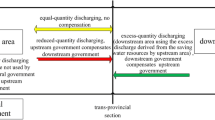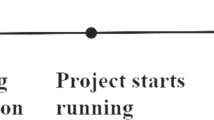Abstract
The Middle Route Project(MRP) of the South-to-North Water Transfer Scheme (SNWT) in China will require a very large financial expenditure to ensure the water supply and the associated water quality to northern China. An eco-compensation mechanism between the water service source areas and its beneficiaries is essential. This paper establishes an analytic framework of ecocompensation standard for the protection of the water source area, including both the calculation of ecocompensation based on opportunity cost method (OCM) and calculation of the burden sharing of eco-compensation between the water source area and the external water reception area based on the deviation square method (DSM). Taking Shiyan City, Hubei Province in China as a case study, our results show that the eco-compensation in the first-phase of MRP for the water source area in Shiyan, Hubei Province should be 1.63×1010 CNY, about four times of planned eco-construction investment budget (4.33×109 CNY). In addition, the burden sharing of eco-compensation varied greatly in terms of different methods. It would be better to integrate the results of different single-factor burden sharing methods by determining the corresponding weighting coefficient with DSM and form one unanimous consent result by the interested parties.
Similar content being viewed by others
References
Yung E C. An ecological perspective on the valuation of ecosystem services. Biological Conservation, 2004, 120(4): 549–565
Jorgensen B S, Wilson M A, Heberlein T A. Fairness in the contingent valuation of environmental public goods: attitude toward paying for environmental improvements at two levels of scope. Ecological Economics, 2001, 36(1): 133–148
Loomis J, Kent P, Strange L, Fausch K, Covich A. Measuring the total economic value of restoring ecosystem services in an impaired river basin: results from a contingent valuation survey. Ecological Economics, 2000, 33(1): 103–117
O’Ryan R. Cost-effective polices to improve urban air quality in Santiago Chile. Journal of Environmental Economics and Management, 1996, 31(3): 302–313
Stoneham G, Chaudhri V, Ha A, Strappazzon L. Auctions for conservation contracts: an empirical examination of Victoria’s BushTender trial. Australian Journal of Agricultural and Resource Economics, 2003, 47(4): 477–500
Cason T, Gangadharan L, Duke C. A laboratory study of auctions for reducing non-point source pollution. Journal of Environmental Economics and Management, 2003, 46(3): 446–471
Ferraro Paul J. Asymmetric information and contract design for payments for environmental services. Ecological Economics, 2008, 65(4): 810–821
Roland B A G, Leon M H. Broadening the picture: Negotiating payment schemes for water-related environmental services in the Netherlands. Ecological Economics, 2009, 68(11): 2760–2767
Bishop R C, Heberlein T A. Measuring values of extra-market goods: Are indirect methods biased? American Journal of Agricultural Economics, 1981, 66(3): 926–930
Henrik S. Economic valuation of the environment: how citizens make sense of contingent valuation questions. Land Economics, 2003, 79(1): 122–135
Li X G, Miao H, Zheng G H, Ouyang Z Y. Main methods for setting ecological compensation standard and their application. Acta Ecologica Sinica, 2009, 29(8): 4431–4440 (in Chinese)
Stefano P. Payments for environmental services in Costa Rica. Ecological Economics, 2008, 65(4): 712–724
Theo D, Paul F, Marjorie H, Douglas S, Shyam U, Sven W. payments for watershed services regional syntheses. 2007, http://www.oired.vt.edu/sanremcrsp/documents/PES.Sourcebook.Oct.2007/PESbrief7.Regional%20Synth.pdf
Ruan B Q, Xu F R, Zhang C L. Review of research and practice of river basin ecological compensation. Journal of Hydraulic Engineering, 2008, 39(10): 1220–1225 (in Chinese)
Liu Y L, Xu F R, Zhang C L, Ruan B Q, Luo Y Z. Model for river basin ecological compensation. China Water Resources, 2006, 22: 36–38 (in Chinese)
Liu X H, Yu X J. Research on standardization of compensation for trans-regional water pollution based on protection of water eco-system in river valley — an empirical analysis of Tai Lake basin. Ecological Economics, 2007, (8): 129–135 (in Chinese)
Zhang C L. The compensation mechanism to restore water resources. Beijing: China Institute of Water Resources and Hydropower Research, 2003, 80–92 (in Chinese)
Cai B C, Lu G F, Song L J, Li J, Liu Z. The ecological compensation standardization for ecological restoration: a case study of ecological restoration in the water resource protection zone for Eastern South-to-North Water Transfer Project. Acta Ecologica Sinica, 2008, 28(5): 2413–2416 (in Chinese)
CAO G H. Jiang D L. Ecological Compensation Solution to transboundary pollution. Ecological Economics, 2009, 11: 160–164 (in Chinese)
Zheng H X, Zhang L B. Research on the standardization of compensation for the service of ecological system in river valley. Environmental Protection, 2006, (A):42–46 (in Chinese)
XU D W, Hu M G, Zheng H X. Measuring method of river basin ecological compensation based on river water quality and its water quantity about across administration area. China Population Resources and Environment, 2008, 18(4):189–194 (in Chinese)
Wang F E, Xu X Y, Fang Z F, Yu J. Quantification of water pollution eco-compensation in Qiantang River watershed based on COD flux. Resources and Environment in the Yangtze Basin, 2009, 18(3): 259–263 (in Chinese)
Zhang Q L, Dang Z L. Report on ecological restoration in the Shanxi water resource protection zone for Eastern South-to-North Water Transfer Project. 2008 (in Chinese)
Macmillan D C, Harley D, Morrison R. Cost-effectiveness analysis of woodland ecosystem restoration. Ecological Economics, 1998, 27(3): 313–324 (in Chinese)
Ram K S, Janaki R R A. Valuing environmental benefits of silvopasture practice: a case study of the Lake Okeechobee watershed in Florida. Ecological Economics, 2004, 49(3): 349–359
Pattanayak S K. Valuing watershed services: concepts and empirics from Southeast Asia. Agriculture Ecosystems & Environment, 2004, 104(1): 171–184
Zhao M H, Xu C G, Huang Q, Tian F W, Xue X J. Application of differential square method for sharing compensation benefits between cascade hydropower stations and for sharing costs between multipurpose water projects. Journal of Hydroelectric Engineering, 2004, 6(23): 1–4 (in Chinese)
Yang Y Z, Chui Y, Shi A N. Research of investment share in Xiaolangdi Key Control Project. Journal of Hohai University, 1999, 27(4): 45–49 (in Chinese)
Shi S J, Li H E, Lin Q C, Dang Z L. Study on method for calculating eco-compensation fund sharing in inter-basin water transfer projects. Journal of Hydraulic Engineering, 2009, 40(3): 268–273 (in Chinese)
Robert C, Ralph D, Rudolf D G, Stephen F, Monica G, Bruce H, Karin L, Shahid N, Robert V O, Jose P, Robert G R, Paul S, Marjan V D B. The value of the world’s Ecosystem services and natural capital. Nature, 1997, 387(6630): 253–260
Xie G D, Lu C X, Leng Y F, Zheng D, Li S C. Ecological assets valuation of Tibetan Plateau. Journal of Nature Resource, 2003, 18(2): 189–195 (in Chinese)
Khan H. Poverty, environment and economic growth: exploring the links among three complex issues with specific focus on the Pakistan’s case. Environment, Development and Sustainability, 2008, 10(6): 913–929
Manzoor E C, Sarwar U A. Poverty-environment nexus: an investigation of linkage using survey data. International Journal of Environment and Sustainable Development, 2010, 9(1): 91–113
John K. Watershed development, environmental services, and poverty alleviation in India. World Development, 2002, 30(8): 1387–1400
Liu J G, Diamond J. China’s environment in a globalizing world. Nature, 2005, 435(7046): 1179–1186
Stefano P, Agustin A, Gunars P. Can payments for environmental services help reduce poverty? An exploration of the issues and the evidence to date from Latin America. World Development, 2005, 33(2): 237–253
Stefanie E, Stefano P, Sven W. Designing payments for environmental services in theory and practice: An overview of the issues. Ecological Economics, 2008, 65(4): 663–674
Li W H. Seeking for the building of the mechanism of ecological compensation in China-An interview with Li Wenhua, the Academician of the Chinese Academy of Engineering. Environment and Progress, 2006, 19: 4–8 (in Chinese)
Author information
Authors and Affiliations
Corresponding author
Rights and permissions
About this article
Cite this article
Dong, Z., Wang, J. Quantitative standard of eco-compensation for the water source area in the middle route of the South-to-North Water Transfer Project in China. Front. Environ. Sci. Eng. China 5, 459–473 (2011). https://doi.org/10.1007/s11783-010-0288-9
Received:
Accepted:
Published:
Issue Date:
DOI: https://doi.org/10.1007/s11783-010-0288-9




